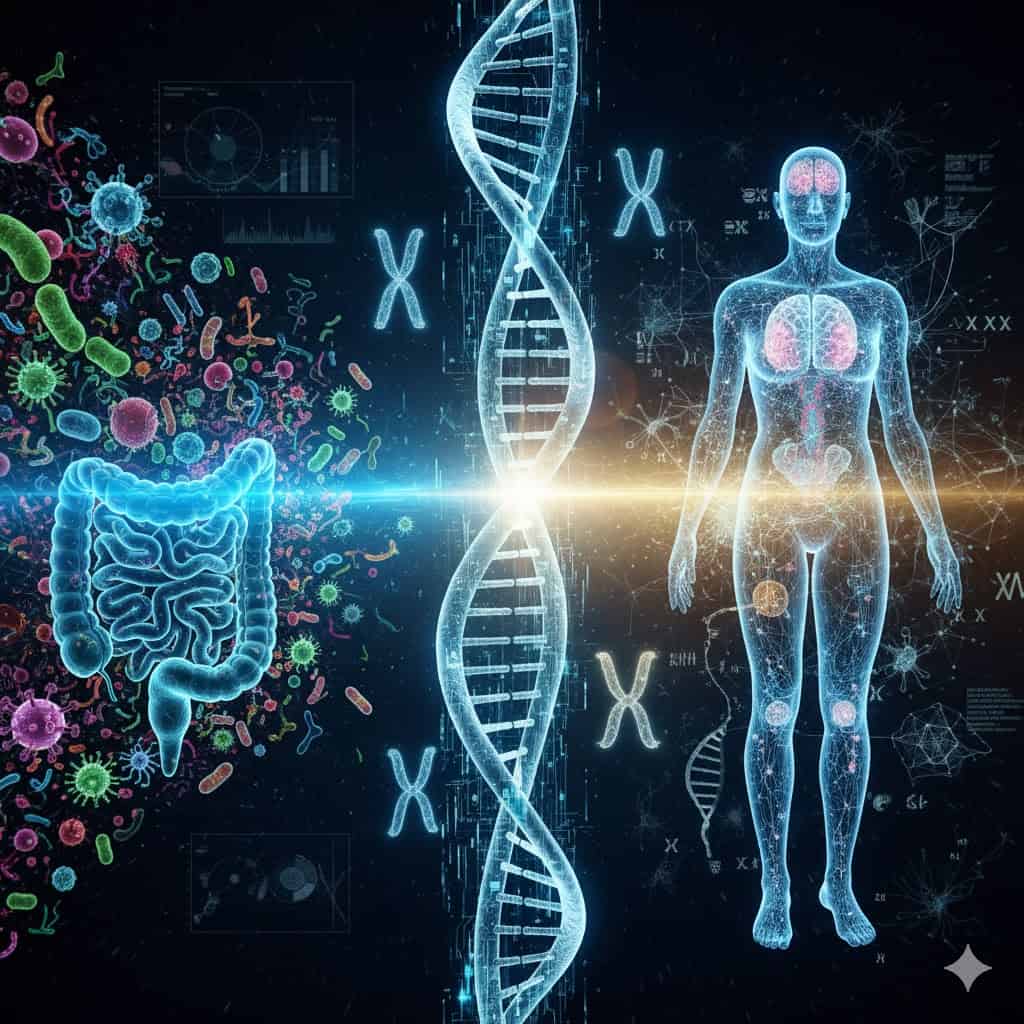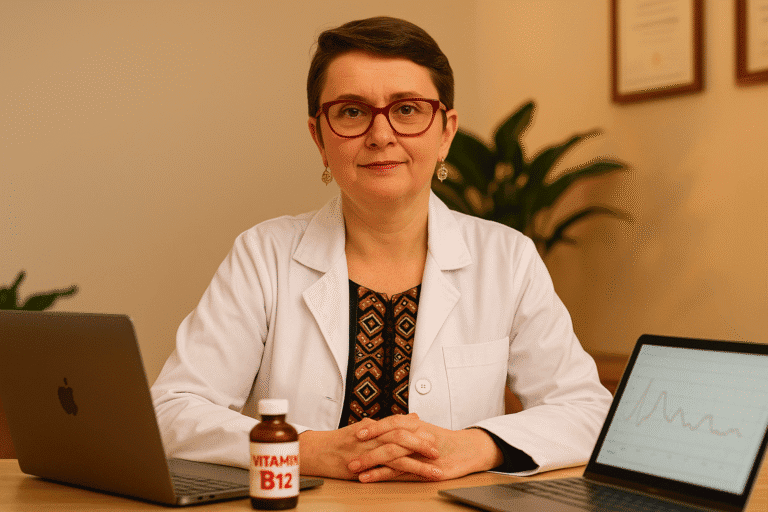Microbiome and Genetics in Longevity

The fascination with longevity
The question “Why do some people live longer and healthier lives than others?” has fascinated humanity for centuries. In the past, myths about magical elixirs or fountains of youth reflected this desire to understand the secret of long life. Today, modern science seeks concrete answers grounded in biology and genetics.
One of the most studied groups is that of supercentenarians – people who live beyond 110 years. They are not just statistical outliers but biological models that help us understand the mechanisms of healthy aging. Two factors appear to be essential: genetics and the microbiome.
Foreigner In Romania and in need of a prescription for your chronic treatment?
Contact Dr. Petrache’s Virtual Clinic for any medical issue you encounter while in Romania. Send an email to: clinica@diabet-si-nutritie.ro
What is the microbiome and why Does it matter?
The microbiome is the collection of all bacteria, fungi, and viruses that live in and on our bodies, particularly in the gut. Although their number often exceeds that of human cells, these microorganisms are not intruders – they are life partners.
The microbiome plays vital roles:
- it participates in the digestion of food and extraction of nutrients,
- produces vitamins (B12, K) and beneficial compounds,
- trains and regulates the immune system,
- influences metabolic health and body weight,
- communicates with the brain through the “gut-brain axis.”
Recent studies show that a diverse and balanced microbiome is a predictor of longevity, while imbalances (dysbiosis) are linked to chronic diseases such as diabetes, obesity, cardiovascular disease, and even cognitive decline.
The role of genetics in longevity
While lifestyle and environment have a huge influence, genetics accounts for about 20–30% of the ability to live longer. Genome analyses of centenarians reveal rare genetic variants associated with:
- more efficient metabolism of fats and sugars,
- protection against oxidative stress,
- improved DNA repair,
- better regulation of the inflammatory response.
These mechanisms protect against age-related diseases such as atherosclerosis, diabetes, and cancer, and slow down the aging process.
The case of Maria Branyas – a modern example
Maria Branyas, who lived to 117 in Spain, became a subject of international research. Before her death in 2024, at the age of 116, she donated blood, saliva, urine, and stool samples for analysis by Spanish scientists.
The results, published in 2025, revealed that:
- her genome contained protective variants linked to resistance against chronic inflammation,
- her gut microbiome was unusually diverse and contained rare species associated with metabolic health,
- her biological markers suggested her biological age was lower than her chronological age.
This case demonstrated that extreme longevity is not just luck, but the outcome of a unique combination of favorable genes and a healthy microbiome.
How the microbiome of centenarians looks
Comparative studies between the microbiomes of young adults and centenarians reveal interesting differences:
- centenarians have higher microbial diversity, which provides resilience,
- they show more bacteria producing short-chain fatty acids (SCFAs), compounds that protect the gut and reduce inflammation,
- they generally lack pathogenic bacteria linked to intestinal or chronic diseases,
- their balance between “friendly” and “harmful” microbes is healthier than that of elderly people with disease.
This suggests that the microbiome is not just a witness to health but an active contributor.
How the genome of supercentenarians looks
Genetic analyses have identified common patterns among those who live past 100:
- genes involved in cardiovascular protection (e.g., rare APOE variants),
- genes that regulate inflammatory responses and lower chronic inflammation,
- genes linked to cellular longevity, through telomere protection and DNA repair,
- genes that support metabolic balance, preventing excessive fat and sugar buildup.
Together, these variants delay the onset of disease and keep vital functions stable for much longer.
Passing through Romania and need a prescription for your chronic treatment?
Contact Dr. Petrache’s Virtual Clinic for any medical issue you encounter while in Romania. Send an email to: clinica@diabet-si-nutritie.ro
Inflammation and oxidative stress
Two key drivers of aging are chronic low-grade inflammation, called inflammaging, and oxidative stress caused by the buildup of free radicals.
Centenarians often display:
- genetic resistance that reduces inflammation,
- a microbiome that helps protect against systemic inflammatory processes,
- enzymes that fight oxidative stress more efficiently, sometimes due to rare genetic variations.
These protective traits shield organs, blood vessels, and even the brain from accelerated damage.
The interaction between microbiome and genes
Genetics and the microbiome do not act in isolation – they interact in a bidirectional relationship:
- genes can shape the predisposition for certain microbial communities,
- the microbiome, through its metabolites, can modulate gene expression.
This means that individuals with both a favorable genetic background and a diverse microbiome enjoy a “double shield” against accelerated aging.
Lessons from supercentenarians
Beyond genetics, lifestyle plays an enormous role. Studies show centenarians often share similar habits:
- simple diets rich in vegetables, legumes, and fermented foods,
- moderate and regular physical activity,
- maintaining a healthy weight,
- active social relationships and emotional support,
- consistent sleep and reduced chronic stress.
These behaviors, coupled with a strong genetic and microbial profile, create the foundation for a long and healthy life.
How we can support a healthy microbiome
While we cannot change the genes we inherit, we can influence our microbiome. Practical recommendations include:
- high fiber intake (fruits, vegetables, whole grains),
- incorporating fermented foods (yogurt, kefir, kimchi, sauerkraut),
- reducing sugars and ultra-processed foods,
- using antibiotics only when necessary,
- staying hydrated,
- engaging in daily physical activity.
These habits help maintain microbial diversity, which is strongly linked to better health outcomes.
The future of longevity medicine
Modern science is exploring therapies that combine genetics and microbiome insights. Some promising directions include:
- microbiome transplants to restore balance,
- personalized probiotics and prebiotics tailored to each individual’s microbiota,
- nutrigenomics – designing diets that match genetic profiles,
- medications that activate protective genes found in centenarians.
The future of longevity medicine will rely on personalized prevention and treatment strategies, merging genetics, microbiome research, and lifestyle interventions.
Tourist in Romania and in need of a prescription for your chronic treatment?
Contact Dr. Petrache’s Virtual Clinic for any medical issue you encounter while in Romania. Send an email to: clinica@diabet-si-nutritie.ro
Conclusion
Longevity is not the product of a single factor but the interplay of genetics and microbiome. Supercentenarians like Maria Branyas illustrate that favorable genes combined with a balanced and diverse gut microbiome can keep the body biologically young even at extreme ages.
Although we cannot alter our DNA, we can shape our microbiome and our environment through daily choices. Diet, exercise, sleep, and social connections all influence how we age.
The future of longevity research shows that the keys to a long life are not mythical but biological. By understanding the dialogue between genes and the microbiome, we may discover practical strategies not only to extend lifespan but to ensure more years lived in good health.
Follow us on:
- FaceBook: Diabetes & Nutrition;
- YouTube: Diabetes Facts.
















